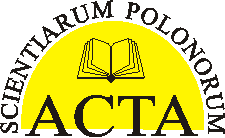Title
Regeneration of somatic embryos from in vitro isolated ligulate florets of chrysanthemum
Autor
Alicja Tymoszuk, Małgorzata Zalewska, Justyna Lema-Rumińska
Keywords
Chrysanthemum × grandiflorum (Ramat.) Kitam., somatic embryogenesis, growth regulators
Abstract
Many chrysanthemum mutants are chimeras built from tissues of a varied genetic composition. Regeneration in vitro of somatic embryos from the whole mutated ligulate florets or only from their small mutated fragments can lead to the separation of chimera components and, as a result, producing a new original cultivar. There was determined the effect of growth regulators (2,4-D; KIN or BAP) and explant type (whole or transversely-cut-into-half ligulate florets) on the efficiency of somatic embryogenesis of Chrysanthemum × grandiflorum (Ramat.) Kitam. ‘Cool Time’. For the induction of the somatic embryogenesis ant the regeneration of somatic embryos the MS medium [Murashige and Skoog 1962] with 18.08 µM 2,4-D as well as with this auxin and 4.44; 8.88; 22.20 µM BAP or 4.65; 9.30; 23.25 µM KIN was used. The best results were obtained when transversely-cut-into-half ligulate florets were inoculated onto the medium with 4.65 µM KIN and 18.08 µM 2,4-D. This results may increase the probability of success in separation of chimera components in chrysanthemum breeding.
Pages
13-22
Cite
Tymoszuk, A., Zalewska, M., Lema-Rumińska, J. (2014). Regeneration of somatic embryos from in vitro isolated ligulate florets of chrysanthemum. Acta Sci. Pol. Hortorum Cultus, 13(4), 13-22.
Full text


